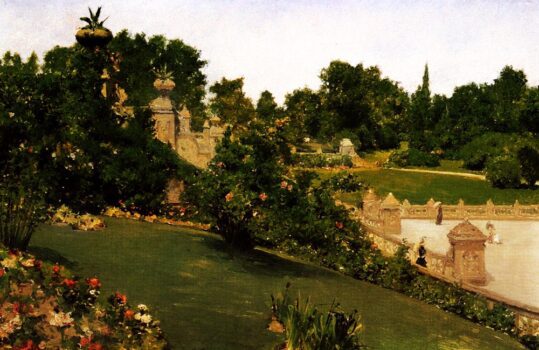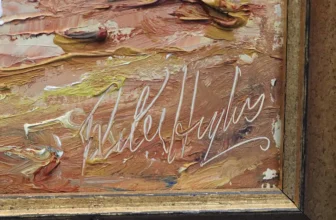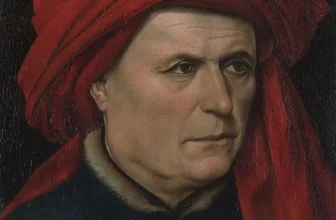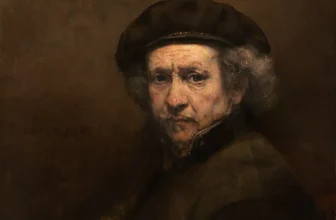Meaning of Terrace at the Mall, Central Park by William Merritt Chase
William Merritt Chase, one of the most influential American artists of the late 19th and early 20th centuries, is celebrated for his unique ability to blend European art traditions with American sensibilities. Among his prolific output, Terrace at the Mall, Central Park stands out as a vivid, atmospheric depiction of New York City’s most famous public space. This painting is more than just a scene of leisurely life; it’s a cultural artifact, a visual poem to modernity, nature, and urban sophistication. Through this in-depth exploration, we will analyze the meaning, symbolism, artistic style, and historical context of this celebrated work. We’ll uncover the story behind the painting, its creation, and its enduring significance in American art history.
Who Was William Merritt Chase?
Born in 1849 in Indiana, William Merritt Chase was a pioneering figure in American art. He was instrumental in introducing European Impressionist techniques to the United States and played a central role in the development of modern American painting. Chase studied at the National Academy of Design in New York and later trained in Munich, where he was exposed to the realism and loose brushwork that would later influence his style.
Though rooted in academic training, Chase was remarkably modern in his outlook. He was both an artist and a teacher, leading classes at the Art Students League of New York and founding the Chase School, which later became Parsons School of Design. His students included many who would shape 20th-century American art, such as Georgia O’Keeffe and Edward Hopper.
The Painting: Terrace at the Mall, Central Park
Painted around 1890–1895, Terrace at the Mall, Central Park is a quintessential example of Chase’s mature style. Measuring approximately 29 x 41 inches, the painting is rendered in oil on canvas and now resides in the Metropolitan Museum of Art in New York City.
The painting captures a sunlit scene of the elegant terrace overlooking the Mall in Central Park, one of the most iconic vistas in Manhattan. It shows well-dressed New Yorkers, likely from the upper-middle class or elite, engaged in quiet leisure, strolling, conversing, or simply sitting. The strong architectural lines of the balustrade, the delicate play of light on the stone, the canopied trees in the background, and the fashionable clothing all serve as elements that create a tapestry of modern urban life and genteel recreation.
What is Happening in the Painting?
At first glance, the painting might appear to be a straightforward genre scene, a moment of ordinary life in a beautiful setting. However, a closer inspection reveals a wealth of subtle storytelling. The composition is carefully structured: the terrace with its classical stone balustrade forms a horizontal platform, anchoring the figures against the vertical lines of the trees beyond. Several figures are engaged in conversation, while others appear to be absorbed in their surroundings or their own thoughts. There is a palpable sense of quietude, decorum, and civility.
These people are not caught in hurried urban motion but in moments of repose, suggesting that Central Park, even in a bustling city like New York, served as a refuge. The park was not only a democratic space but a social arena, a place to see and be seen.
The Meaning and Representation
Terrace at the Mall, Central Park is more than a representation of a literal place. It encapsulates the ideals and aspirations of a burgeoning American bourgeoisie. The painting shows how Central Park, designed by Frederick Law Olmsted and Calvert Vaux, functioned as a new kind of civic space. Built as a response to the industrialization and chaos of urban life, the park was meant to bring pastoral peace to city dwellers. Chase’s work emphasizes this ideal by showing people harmoniously interacting with their environment.
The terrace, elevated and structured, symbolizes order, refinement, and architectural beauty, qualities associated with the cultured class that Chase admired. In the lushness of the trees and the dappled light, we see nature idealized, not wild or untamed, but cultivated and controlled, much like the people in the painting themselves. There’s a clear resonance with the aesthetic values of Impressionism, where everyday life is elevated into art through composition, color, and atmosphere.
Artistic Style: American Impressionism
Chase’s Terrace at the Mall, Central Park is a textbook example of American Impressionism, a movement that flourished from the 1880s to the 1910s. While French Impressionism emphasized spontaneity and visual immediacy, American Impressionism was more restrained and often focused on themes of leisure, domesticity, and landscapes.
Chase adopted the Impressionist fascination with light and atmospheric effects but fused it with a more structured, sometimes academic approach to composition. In this painting, you can see the influence of Manet and Whistler in his attention to modern life and tonal harmony, but also the impact of the Munich school in the strong drawing and solidity of form.
His brushwork is loose yet deliberate. The textures of stone, foliage, and fabric are suggested with painterly gestures, and the palette is sun-drenched, dominated by warm creams, light blues, and the green of early summer. There’s a liveliness to the paint that mimics the shimmer of light itself.
Symbolism in the Painting
Beneath the surface realism, Chase embeds layers of symbolism that speak to broader social and cultural themes:
1. Terrace as a Platform of Civility
The terrace represents civilization, a raised platform from which humanity can appreciate nature without being overwhelmed by it. This parallels the idea of culture refining human behavior, a value held dearly by the American upper class of the Gilded Age.
2. The Mall as a Social Space
The Mall in Central Park was designed to be a grand promenade, a space for public gathering and elegant display. In this painting, it acts as a symbol of American democratic ideals, where all classes could, in theory, coexist. Chase, however, focuses on the more refined social tier, subtly reinforcing class distinctions through dress and demeanor.
3. Fashion and Identity
The carefully rendered attire of the figures symbolizes not just personal wealth but cultural aspirations. These people are not only enjoying the park, they are performing social roles. Their appearance speaks to a society deeply invested in propriety, refinement, and status.
4. Nature and Modernity
Unlike the untamed landscapes of earlier American painting, Chase’s nature is domesticated and integrated into modern life. Trees are aligned, pathways are groomed, and sunlight is filtered. This symbolizes the reconciliation between urban life and pastoral ideal, a core concept in late 19th-century American thought.
The Process and Creation of the Painting
Chase was known for painting en plein air (outdoors), a practice he likely employed while creating Terrace at the Mall, Central Park. He was a regular visitor to Central Park and often used it as a subject in his classes and paintings. Observing his students sketch in the park, he would sometimes produce his own works alongside them.
It’s likely that Chase made initial studies or sketches on location, capturing the fleeting effects of light and movement, and later refined the painting in his studio. His training in the Munich school gave him a strong foundation in drawing, which he combined with the freer brushwork of Impressionism to create a balanced, elegant composition.
This duality, of spontaneity and structure, is at the heart of Terrace at the Mall, Central Park. The viewer can sense the immediacy of the moment, but also the deliberate hand that shaped it into a timeless image.
New York and the Gilded Age
Painted during the 1890s, Terrace at the Mall, Central Park reflects a period of dramatic change in American life. The Gilded Age was marked by industrial expansion, wealth accumulation, and increasing social stratification. At the same time, cities like New York were undergoing a transformation, emerging as centers of culture, power, and sophistication.
Central Park, completed in the mid-19th century, was one of the earliest and most ambitious urban parks in the world. It became a symbol of progressive urban planning and was integral to the cultural identity of the city. Chase’s painting, then, isn’t just a picture of people in a park, it’s a celebration of a new kind of American city life, one that valued beauty, civility, and community.
Where is the Terrace at the Mall, Central Park Painting Now?
Terrace at the Mall, Central Park is part of the collection of the Metropolitan Museum of Art in New York City. It is housed within the museum’s American Wing, where it continues to be viewed and studied by art historians, students, and the general public.
As a work housed in one of the world’s greatest art museums, the painting enjoys a prominent place in the story of American art. Its location in New York, just a short distance from the very site it depicts, adds a powerful layer of authenticity and continuity.
Why Terrace at the Mall, Central Park Still Matters
William Merritt Chase’s Terrace at the Mall, Central Park is not just a beautiful painting, it is a cultural mirror reflecting the aspirations, values, and aesthetics of its time. Through it, we glimpse a world in which art, nature, and society were harmoniously intertwined. The work captures a moment when America, especially urban America, was finding its cultural identity and asserting its sophistication on the global stage.
This painting endures not only because of its technical mastery but because it speaks to universal themes: the search for beauty, the interplay between civilization and nature, and the quiet dignity of everyday life. Chase, with his painter’s eye and philosopher’s heart, distilled these ideas into an image that continues to captivate and resonate over a century later.
Whether viewed as an Impressionist landscape, a social commentary, or a personal meditation on leisure and refinement, Terrace at the Mall, Central Park remains a cornerstone of American art and a tribute to the enduring power of the painted image.




